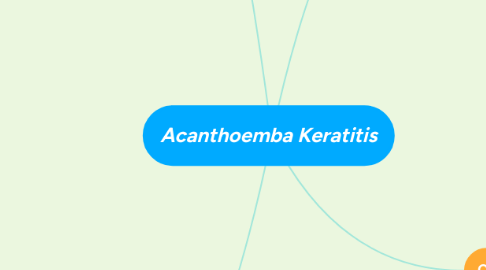
1. Investigations
1.1. Conventional Lab methods
1.1.1. Microscopic examination of smears and inoculation of scraped specimen on various culture media like Blood agar,Chocolate agar, PDA,SDA,Non nutrient agar with Ecoli, Thioglycolate Broth,Robertson Cooked Meat Broth
1.1.1.1. The Acanthamoeba cysts are seen as double‑walled structure with inner wall being hexagonal on microscopic examination of smears stained with calcofluor‑white or Gram stain -- that provide immediate diagnosis
1.1.1.2. The culture confirmation on nonnutrient agar with Escherichia coli overlay may take 1–3 days
1.1.1.2.1. The medium, however, should be incubated for up to 2 weeks before concluding it as a negative culture
1.1.1.3. Reasons for negative scraping
1.1.1.3.1. Inadequate scraping- From non active areas, areas of scarring
1.1.1.3.2. Highly active stage of infection- Tropozoites are abundant, cysts are few
1.1.1.3.3. Deeper infiltration of cysts into the stroma
1.1.1.3.4. Prior use of antibiotics- Acanthoemba cysts stay deeper in stroma
1.1.1.3.5. Hurried examination- Not examining all fields under microscope
1.2. Polymerase chain reaction (PCR)
1.2.1. 84–100% sensitivity and gives result within 60 min
1.3. In vivo confocal microscopy
1.3.1. 90% sensitivity in experienced hands. Confocal microscopy provides in vivo high magnification sectioning of the cornea by timing transmission and reception of reflected light to a narrow plane, reducing scatter, to improve optical resolution
1.3.2. Acanthamoeba cysts appear as oval to round, double-walled, highly refractile structures with a polygonal inner wall, varying in size between 12 to 25 microns
1.3.2.1. Other round structures that could be confused with Acanthamoeba cysts are inflammatory cells, macrophages and epithelial cells
1.4. Corneal Biopsy
1.4.1. Deep infiltrate and negative scraping
1.4.1.1. Histopathological analysis- 31–65% sensitivity.
1.4.1.2. Periodic acid-Schiff, Masson, Giemsa, Grocott-methenamine-silver stain.
2. Management
2.1. Medical Management
2.1.1. Biguanides and diamidines have the best in vitro cysticidal activity
2.1.2. vast in vivo experience in peer‑reviewed literature
2.1.2.1. Topical biguanides with or without the addition of diamidines are the main stay of medical management
2.1.2.1.1. Combination of PHMB 0.02% and chlorhexidine 0.02% is used as the primary therapy
2.1.2.1.2. Mean duration of treatment-0.5–29 months
2.1.3. Indications for steroids
2.1.3.1. Controversial
2.1.3.1.1. Main indications include-Increase in deep vascularization of the cornea
2.1.3.1.2. Scleritis, AC inflammation (hypopyon), persistent chronic keratitis
2.1.3.1.3. Intractable pain
2.1.4. Antifungals
2.1.4.1. Not be relied on as sole therapy
2.1.4.1.1. Reports on successful treatment of infection with the addition of voriconazole in patients not responding to conventional anti‑Acanthamoeba treatment
2.1.5. Oral Miltefosine
2.1.5.1. Alkylphosphocholine anti-amoebic drug – used along with other drugs for treating granulomatous amoebic encephalitis
2.1.5.2. FDA approved for visceral leishmaniasis
2.1.6. RB-PDAT
2.1.6.1. Rose bengal is a dye which when activated by green light having a wavelength of 500-550nm produces various reactive oxygen species, out of which the singlet oxygen has the greatest antimicrobial effect
2.1.6.1.1. Adjunct therapy for cases of severe, progressive infectious keratitis before performing a therapeutic keratoplasty
2.2. Surgical Management
2.2.1. Indications
2.2.1.1. Large infiltrate extending or threatening to involve limbus
2.2.1.2. Worsening on medical treatment
2.2.1.3. Gross thinning or actual perforation
2.2.2. DALK
2.2.2.1. Deep lamellar keratoplasty has been shown to be associated with better prognosis both for eradicating infection as well as graft survival
2.2.2.1.1. Sarnicola et al successfully performed early DALK in 11 cases of non-responsive AK with no recurrence or rejection.
2.2.2.1.2. Our own experience(Bagga etal) DALK in cases of refractory AK showed that outcomes were less favourable for advanced keratitis with infiltrate size >/= 8mm as compared to less severe keratitis with infiltrate size <8mm
2.2.3. Therapeutic PK
2.2.3.1. Robaei etal
2.2.3.1.1. TKP were more likely to have multiple keratoplasties and other ocular surgeries
2.2.3.1.2. TKP higher risk of recurrence and shorter graft survival
3. Epidemiology and Risk factors
3.1. In Developing countries like India, Acanthamoeba accounts for 2% of all cases of culture‑positive corneal ulcers
3.2. Acanthoemba Keratitis in CL users-Comprises of <5% of Contact lens‑related microbial keratitis
3.2.1. 80–85% cases of Acanthoemba Keratitis in the UK, the United States, and other developed Asian countries
3.3. Risk factors -Trauma and exposure to contaminated water or soil(Most common in developing countries)
3.3.1. Other risk factors-
3.3.1.1. warmer weather, poor socioeconomic conditions and after surgical trauma like penetrating keratoplasty,radial keratotomy and laser refractive surgery
4. Clinical features
4.1. Early features
4.1.1. The initial clinical presentation is remarkably varied and non-specific
4.1.1.1. Epithelial Microerosions
4.1.1.1.1. These are flat, diffuse microcystic form that exhibits relative paralimbal epithelial sparing and can be confused with dry eye or surface toxicity
4.1.1.2. Epithelial ridges and Elevated epithelial lines giving an appearance of a pseudodendrite are also seen
4.1.1.3. Radial Keratoneuritis
4.1.1.3.1. They represent amoebic migration along the corneal nerves and the host immune response to it.It occurs in mid or deep stroma beginning centrally or paracentrally and extends towards the limbus.
4.1.1.4. Patchy stromal infiltrtaes
4.2. Late features
4.2.1. Ring Infiltrate
4.2.1.1. Ring infiltrate represents an immune reaction which may be related or unrelated to the viability of the organisms.
4.2.2. Total Corneal Infiltrate
4.2.3. Perforated corneal ulcer
4.2.4. Extracorneal manifestations
4.2.4.1. Limbitis
4.2.4.1.1. Limbitis can be seen in early as well as late stage
4.2.4.2. Sclertitis/Sclerokeratitis
4.2.4.2.1. Scleral involvement occurs in the form of a boggy swelling noted with dilated episcleral and scleral vessels.
4.3. Acanthoemba is commonly misdiagnosed
4.3.1. Suspect Acanthoemba Keratitis if
4.3.1.1. Corneal infiltrtae with radial keratoneuritis
4.3.1.2. Chronic Keratitis with ring infiltrate
4.3.1.3. Suspected HSV keratitis not responding to anti‑HSV therapy
4.3.1.4. Ulcerative keratitis not responding to antibacterial or antifungal therapy
